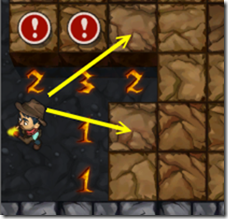- Introduction and General Strategies
- General Patterns
- Row Patterns
- Corner Patterns
- Specific Patterns
- Subtraction
- Chording
- Analysis
- Level 86 Walk Through
Analysis
When just a few unexposed squares are involved, drawing it out on paper and using trial and error can work out a solution. That can become tedious, and prone to mistakes when the numbers increase. A little reasoning can save some time. Consider this example from level 48:
The exit wound
In order to satisfy three traps adjacent to the 3, one of the two squares marked with the arrows must be a trap, but we cannot say which one it is; however, both possibilities are adjacent to the 2, accounting for all its traps. That means the three squares beside and to the right of the 2 cannot be traps. I call this pattern the “exit wound” because it opens up a large space beyond the entrance. Here’s another pattern that can use the exit wound strategy:
The entrance “1” must have a trap below or above, meaning that the three spaces to the right (here shown after exposure as “2”) cannot be traps. In the following before and after, we see the central “1” opening up the three spaces to its right as well as additional spaces opened up because they were part of an area free of traps.


Here’s another one:
Both of the possible squares for the third trap adjacent to the three are also adjacent to the “1” which means that the other 5 squares adjacent to the “1” cannot be a trap.
OK, one more:
Note that at least one of the three traps adjacent to the “3” must be adjacent to the “1” at the bottom, meaning that the two squares on either side, and the three squares below the “1” are clear. With that insight, it was possible to clear out the remainder of a 4 x 9 area from Level 181 easily.





Actually, in the last example, since there is a wall around 3 sides of this example, the square below the 1 on the left MUST be a flag, which means that all the other squares adjacent to the lower-most 1 must be open.
Otherwise, really good blog. The subtraction idea to create simpler patterns was very useful.
I seconde Laura Whitten’s remark…HUGE “AHA” for me.
This “exit wound” analysis is a real “aha” moment for me. Thank you, thank you….